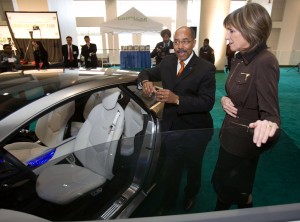
Carol Browner (right) director of the Office of Energy and Climate Change listens as GM Vice President Global Design Ed Welburn gives her a tour of the Cadillac Converj electric luxury coupe.
Cadillac officials have confirmed plans to add a pair of new products that will expand the brand at its extremes.
The news came at an unusual background briefing as General Motors officials pulled the wraps off a wide variety of future product programs going out to 2011, including two new Caddy models tentatively dubbed the ATS and the XTS4. They’re a critical part of what the division’s new general manager, Bryan Nesbitt, described as the “reinvention of Cadillac.”
The XTS4 is the much-needed replacement for two existing products, the slow-selling STS and DTS models. Vaguely reminiscent of the heralded Cadillac Sixteen concept vehicle, the XTS4 will target top-line premium luxury competitors, such as the BMW 7-Series and the Mercedes-Benz S-Class.
The ATS, on the other hand, will slot in below Cadillac’s current entry model, the CTS, and take aim at models like the BMW 3-Series, Audi A4 and Lexus IS.
“The 3-Series is BMW’s bread-and-butter,” noted Nesbitt, in a conversation with TheDetroitBureau.com, and “We’d like to think” the ATS could become the best-seller for Cadillac, once it hits market.
Cadillac of course has tried to enter this market before with the Chevrolet Cavalier-derived Cimarron, and the Opel Omega derived Catera. Now, presumably it will use a compact Opel platform once again for its latest attempt to stop a decades long decline in sales and reputation.
Both products underscore the continuing evolution of the “Art and Science” design theme that has been at the heart of the so-called “Cadillac renaissance,” which kicked off with the launch of the first-generation CTS, nearly eight years ago. But the edgy approach to styling fell flat when Cadillac launched its most recent big cars, the front-drive DTS and rear-drive CTS, acknowledged Caddy’s chief designer, Clay Dean.
“What Cadillac’s small car customers want is very different from what a buyer for an XTS wants,” he explained, pointing to the XTS, “a beautiful, flowing, sculptural design without hard edges.”
The big XTS4 still has some classic Art and Science cues, such as the dominant vertical head and tail lamps, the bright Cadillac grille, and one key hard edge, a character line running down the side of the vehicle.
But the overall look is more elegant and refined, with a definitive presence that better fits into the premium luxury segment than the angular STS.
While the current Caddy line-up primarily relies on the GM Sigma architecture, the platform for the new car “takes bits and pieces” from a variety of architectures, according to Dean.
The “4” in the vehicle’s name refers to the fact that it is an all-wheel-drive model. It is likely, however, that a front-drive version will also be offered, according to various Cadillac officials. The specific platform details aren’t yet being released, but insiders hint a high-mileage V-6, probably a version of the Cadillac Direct-Injection 3.6-liter powertrain, will be in the mix. Meanwhile, a bigger offering could be based on the next generation of GM small block V-8s, including a 5.5-liter engine, due out next year.
A V-8 is unlikely, however, for the much smaller ATS compact, which is a full class size smaller than the current CTS, putting it more on a par with the BMW 3-series, long the dominant player in the global entry-luxury market.
The model shown to journalists was a concept coupe, and in many ways, it is even more angular than the CTS. But like the bigger, softer XTS, the entry-level Caddy boasts an exaggerated C-pillar, a common styling theme that will run from top to bottom in the divisional design vocabulary.
In production form, both the fastback-like coupe, as well as a sedan, will be offered, and there are hints yet other variants could be in the offing. As with the CTS, Cadillac will produce the ATS in rear and all-wheel-drive configurations.
“The goal is to offer a very enthusiastic driving experience,” explained Nesbitt. “We want customers to walk away saying this is agile, this fits me like a glove.”
Continuing the evolution of the Cadillac look is critical, division officials emphasized, noting that they still face plenty of challenges regaining their once-leading position within the global luxury pantheon.
“It really takes about three generations of product to rebuild a reputation and rebuild presence,” said designer Dean, noting that work is already underway on the third-generation CTS.
The ATS and XTS4 will likely not be the last new models to carry the Cadillac wreath-and-crest, however. The division is actively sounding out potential buyers to see if there’s a market for the Converj, the extended-range electric vehicle concept that was shown earlier this year. Based on the Chevrolet Volt, but with a totally different look, it would give buyers the ability to drive about 40 miles on battery power alone, but still have a backup gasoline engine for longer drives.
Many traditional luxury buyers are opting to add “green” machines, like the Toyota Prius, to their personal fleets, noted Nesbitt. So, the company believes Converj “could compliment the Cadillac portfolio.” He said. “The question is whether there’s a business case there.”
If one can be made, Converj could join the Caddy line-up early in the next decade, according to division sources. As for ATS and XTS4, no formal launch dates have been set, but close insiders hint they could be ready for production by the 2012 model-year.
